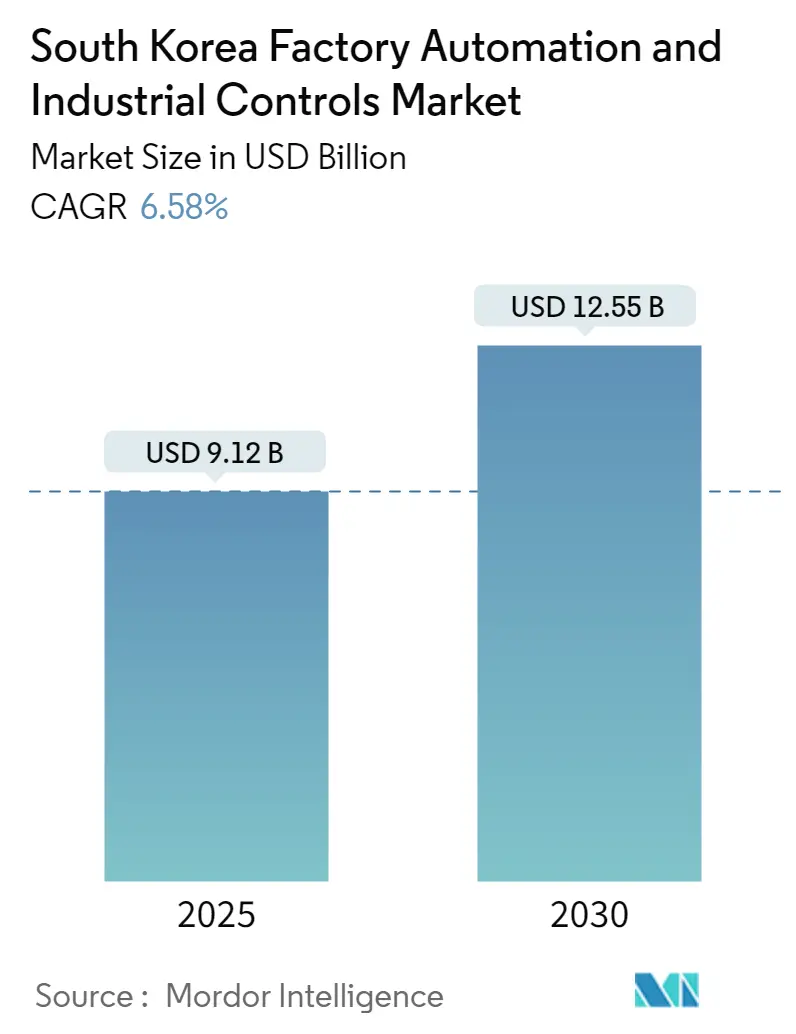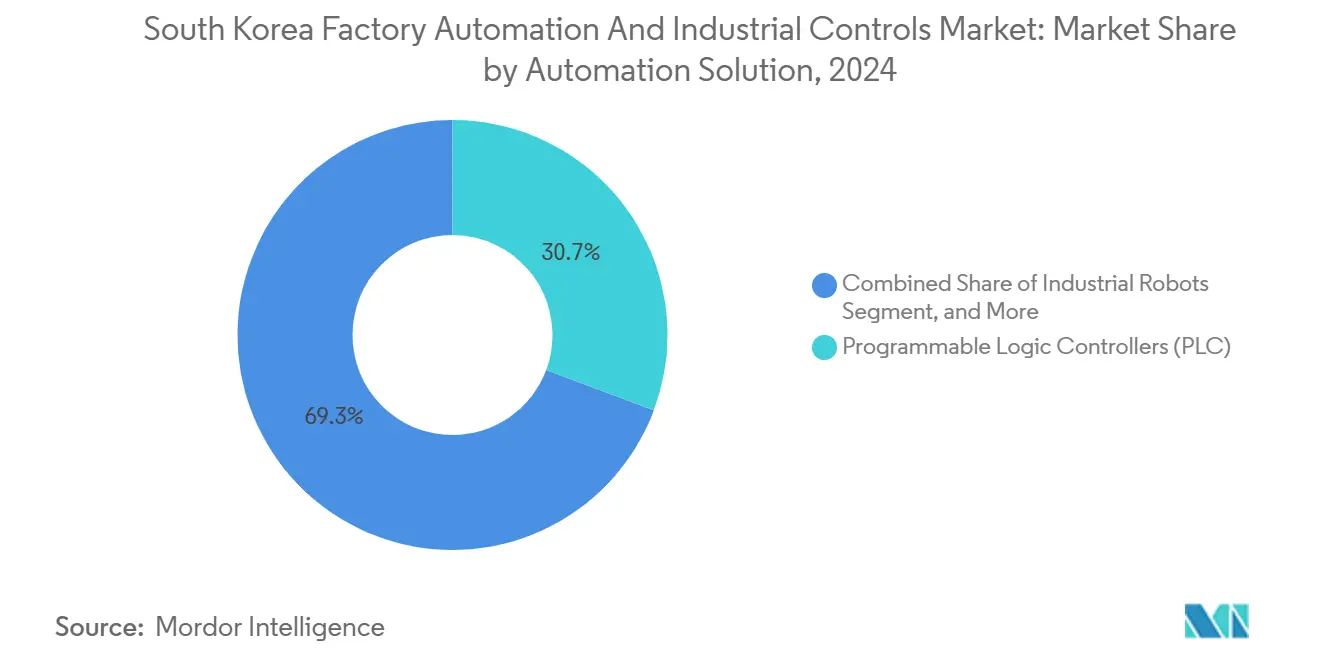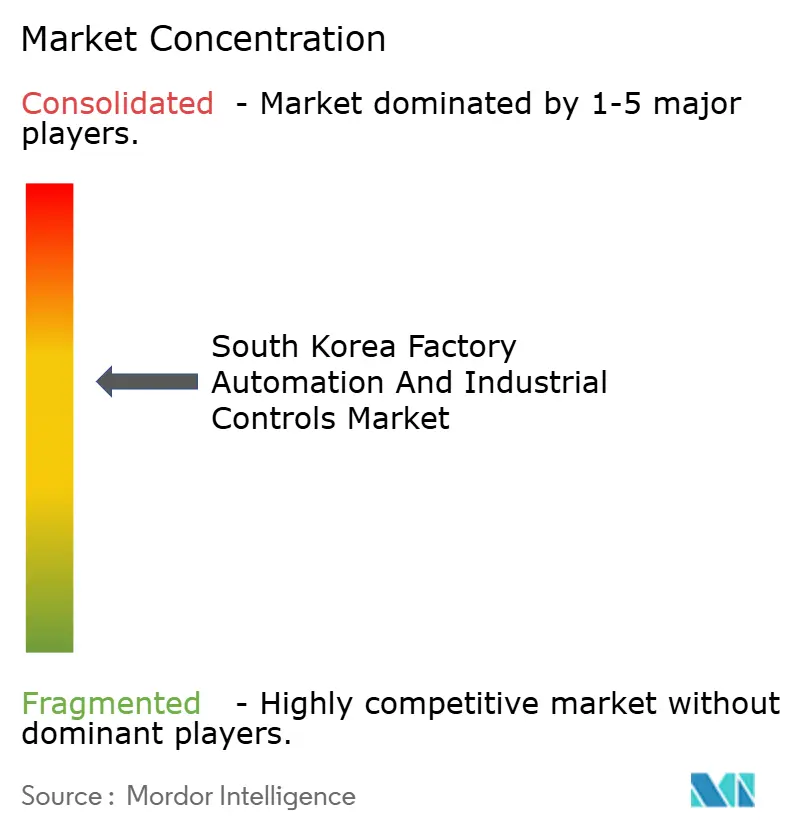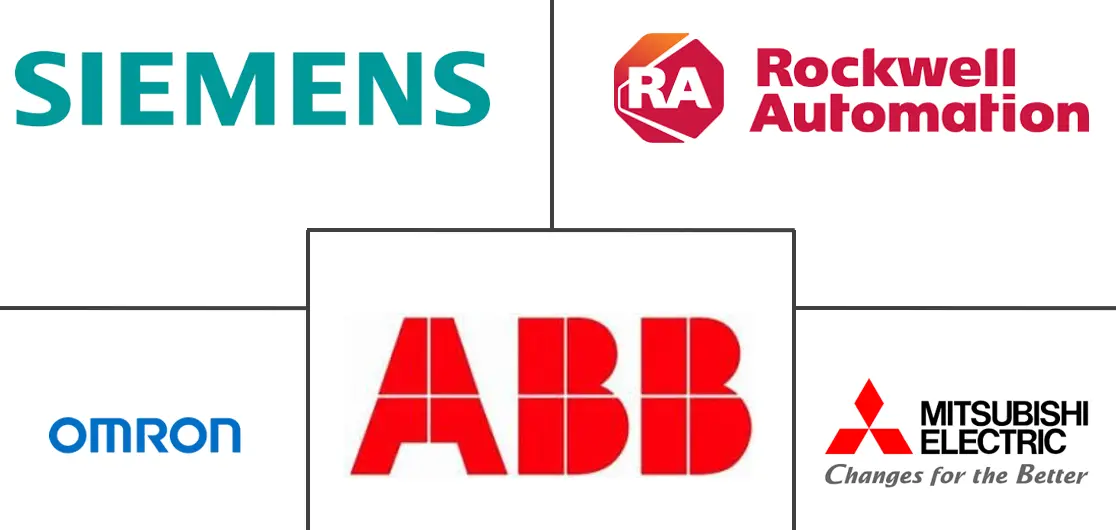
South Korea Factory Automation And Industrial Controls Market Analysis by Mordor Intelligence
The South Korea Factory Automation and Industrial Controls market size is valued at USD 9.14 billion in 2025 and is forecast to expand to USD 12.59 billion by 2030 at a 6.60% CAGR, supported by the government’s Smart Factory Plus incentives, surging 5G coverage, and sustained semiconductor capital expenditure. Automation demand is intensifying because manufacturing employment declined by 8.2% between 2020 and 2024, even as factory output climbed by 12.4%, forcing producers to offset labor shortages with productivity-boosting equipment. Programmable Logic Controllers (PLCs) remain foundational, capturing a 25.7% share in 2024, while industrial robots lead new investment at a 9.2% CAGR as electric-vehicle (EV) and chip fabs overhaul their production lines. Hardware continues to dominate revenue with a 56.8% share, but software is scaling faster, with a 7.8% CAGR, as digital-twin projects and predictive analytics shift value toward data-driven performance. Regionally, the Seoul Capital Area holds a 48.4% share, while the Chungcheong Region is the growth hotspot, with an 8.0% CAGR, thanks to multibillion-dollar semiconductor and battery projects.
Key Report Takeaways
- By product type, PLCs led the South Korean factory automation and industrial controls market with a 25.7% market share in 2024; industrial robotics is projected to record a 9.2% CAGR through 2030.
- By component, hardware accounted for a 56.8% share of the South Korea factory automation and industrial controls market size in 2024, while software is poised to expand at a 7.8% CAGR to 2030.
- By automation solution, PLCs maintained a 30.7% share of the South Korea factory automation and industrial controls market in 2024; industrial robots are forecast to advance at an 8.2% CAGR between 2025-2030.
- By end-user industry, general manufacturing held a 29.28% share of the South Korea factory automation and industrial controls market in 2024, and automotive is advancing at an 8.6% CAGR as EV programs scale.
- By region, the Seoul Capital Area contributed 48.4% of the 2024 revenue of the South Korean factory automation and industrial controls market; however, Chungcheong is on track for an 8.0% CAGR through 2030 as semiconductor megaprojects proceed.
South Korea Factory Automation And Industrial Controls Market Trends and Insights
Drivers Impact Analysis
| Driver | (~) % Impact on CAGR Forecast | Geographic Relevance | Impact Timeline |
|---|---|---|---|
| Smart Factory Plus incentives | +1.2% | National; strongest in Seoul and Chungcheong | Medium term (2-4 years) |
| 5G-enabled Industrial IoT roll-outs | +0.9% | Seoul, Chungcheong, Yeongnam | Short term (≤ 2 years) |
| Rising labor costs and aging workforce | +1.4% | Nationwide; acute in general manufacturing and automotive | Long term (≥ 4 years) |
| Carbon-neutrality and energy-savings mandates | +0.8% | National; early in semiconductor and chemical plants | Medium term (2-4 years) |
| Semiconductor supply-chain localization | +1.1% | Chungcheong and Yeongnam | Medium term (2-4 years) |
| Collaborative-robot tax credits for SMEs | +0.6% | National; clusters of SME workshops | Short term (≤ 2 years) |
| Source: Mordor Intelligence | |||
Government-backed Smart Factory Initiative 4.0 Incentives Drive Systematic Digitization
The Smart Factory Plus program provides up to 75% grants and tax credits on qualified automation purchases, lowering payback periods for SMEs to below 18 months and accelerating adoption beyond organic budgets. System integrators reported a 340% revenue spike in 2024 as firms rushed to meet subsidy deadlines before tapering off in 2026. Preferential financing terms for collaborative robots enabled Hanwha Robotics to surpass 1,200 domestic installations within a year. The policy also mandates standardized communication protocols, cutting integration times by 30% compared with pre-program projects. Early adopters now boast higher OEE (overall equipment effectiveness) scores, thereby strengthening the export competitiveness of Korean-made goods.
Accelerating 5G-enabled Industrial IoT Deployment Transforms Real-time Operations
Nationwide 5G ensures sub-10 ms latency, letting fabs stream thousands of sensor signals to edge-AI engines for instant defect detection and energy optimization.[1]Samsung Electronics, “Semiconductor Manufacturing Expansion Announcements,” samsung.com Samsung’s Pyeongtaek line trimmed defect rates by 23% and electricity use by 18% after wiring 15,000 nodes through 5G gateways. Hyundai Motor synchronizes schedules with 47 tier-1 suppliers in real-time, reducing inventory buffers by 12 days at the Ulsan complex. LG Energy Solution boosted equipment uptime by 31% and saved USD 12.4 million annually via 5G-enabled predictive maintenance at its Ochang battery facility.[2]LG Energy Solution, “Ochang Battery Plant Automation Implementation,” lgensol.com The connectivity layer positions South Korean factory automation and Industrial Controls market participants to deliver premium, ultra-reliable systems for export contracts that demand deterministic networking.
Rising Labor Costs and Aging Workforce Create Automation Imperative
Workers aged 50 and above now represent 41% of the manufacturing labor pool, up from 28% in 2019, while average shop-floor wages have climbed 34% over the same period, eroding cost advantages. Shipbuilders such as Daewoo Shipbuilding faced 15% annual wage inflation despite staff reductions, prompting rapid adoption of lift-assist and welding cobots. Hyundai Heavy Industries installed 340 collaborative robots, which reduced injury cases by 17% and enabled older artisans to remain productive. SMEs feel the pinch most acutely; 68% postponed automation in 2024 due to cash-flow strain, even with low-interest loans. Consequently, demand is shifting toward modular, human-centric solutions that augment rather than replace experienced operators.
Corporate Carbon-neutrality Targets Drive Energy-efficient Automation
Mandatory carbon-intensity ceilings introduced in 2024 are expected to propel investment in AI-based energy management systems that dynamically adjust set-points to minimize kilowatt consumption. POSCO invested USD 2.1 billion in automated controls, reducing emissions by 12% while maintaining tonnage levels. SK Hynix reduced power consumption by 25% at its Icheon fab by utilizing algorithms that schedule high-load steps during grid off-peak windows. Vendors now command 15-20% price premiums for controllers that are bundled with verified energy-saving functions. These gains enhance the export appeal of Korean-developed green automation technologies as global OEMs pursue sustainability targets.
Restraints Impact Analysis
| Restraint | (~) % Impact on CAGR Forecast | Geographic Relevance | Impact Timeline |
|---|---|---|---|
| High upfront CAPEX and integration complexity | -0.7% | Nationwide; especially SME job shops | Short term (≤ 2 years) |
| Scarcity of OT-IT integration talent | -0.9% | Seoul and Chungcheong hubs | Medium term (2-4 years) |
| Legacy-equipment compatibility hurdles | -0.5% | Traditional clusters nationwide | Medium term (2-4 years) |
| Export-control limits on motion-control parts | -0.4% | Precision manufacturers | Long term (≥ 4 years) |
| Source: Mordor Intelligence | |||
High Upfront Capital Expenditure and Integration Complexity Constrain SME Adoption
Even after subsidies, many SMEs still face out-of-pocket costs equivalent to 1.5-2.2 times their annual EBITDA, causing 68% to defer projects in 2024. Hidden engineering and commissioning fees can inflate budgets 40-60%, while typical roll-outs halt production for up to 12 weeks, jeopardizing cash cycles for thin-margin suppliers.[3]Korea Industrial Technology Association, “OT-IT Integration Specialist Certification Report,” koita.or.kr Some integrators now market modular plug-and-play cells; however, these packages often deliver only incremental efficiency gains compared to fully unified lines. Banks hesitate to extend unsecured credit to firms without a long audit history, thereby prolonging funding lead times despite government loan guarantees. Collectively, these hurdles dampen short-term growth in the South Korean Factory Automation and Industrial Controls market.
Scarcity of OT-IT Integration Talent Creates Implementation Bottlenecks
South Korea has only 2,400 certified OT-IT specialists to support more than 45,000 factories, resulting in consulting fees of USD 1,200-1,800 per day and extending project timelines by months. Universities often lag behind industry needs because curricula seldom integrate control engineering with cybersecurity, creating a pipeline mismatch. Large conglomerates launched in-house academies, but training cycles stretch 18-24 months, leaving near-term capacity gaps. International advisors could help, yet language barriers and data-sovereignty rules restrict their participation in high-security plants. Until the talent deficit narrows, integration delays will temper the otherwise robust CAGR outlook.
Segment Analysis
By Product Type: Industrial Robotics Leads Innovation Wave
Industrial robotics captured the spotlight, registering a 9.2% CAGR forecast through 2030, as demand for EV batteries and advanced semiconductor lines requires micron-level precision beyond conventional automation. PLCs secured a 25.7% share of the South Korean Factory Automation and Industrial Controls market in 2024, underscoring their indispensable role as real-time logic engines across both legacy and digital factories. Safety controllers and emergency-stop devices benefited from stricter 2024 workplace mandates, resulting in a 14% year-over-year increase in shipments. Machine-vision systems have grown in tandem with robotics, as higher-resolution inspection stations now detect defects 50% smaller than prior benchmarks. At the opposite end of the curve, power supplies faced margin squeeze as commoditization invited lower-cost entrants.
The trajectory reveals a transition from labor-replacing arms to collaborative, AI-enabled teammates; cobots already command 23% of 2024 robot revenues, up from 8% two years earlier. That acceleration signals a structural shift toward flexible, low-barrier deployments suited to mixed-model production runs. Vendors pairing vision with robotics inside turnkey cells have cut programming time by 35%, appealing to SMEs that lack in-house engineers. The interplay of safety regulation, demographic strain, and product customization pressure thus cements robotics as the pace-setter for future spending within the South Korean Factory Automation and Industrial Controls market.

Note: Segment shares of all individual segments available upon report purchase
By Component: Software Gains Strategic Importance
Hardware still generated 56.8% of 2024 revenue, yet software expanded at a 7.8% CAGR, as digital-twin models, AI analytics, and cloud SCADA unlock productivity that pure hardware cannot replicate. The adoption of subscription-based MES platforms increased from 18% in 2022 to 34% in 2024, as CFOs favored operating expenditures over large license payments. Hyundai Motor invested USD 180 million in virtual plants that test process tweaks in silico, reducing line-change downtime by 42%. Services installation, remote monitoring, and predictive-maintenance outsourcing round out the stack, capturing steady growth by offloading complexity from resource-strapped factories.
The shift mirrors global best practices: hardware establishes data points, software orchestrates insights, and services sustain uptime. As vendors embed edge-AI into PLC firmware and expose open APIs, buyers increasingly select ecosystems, not standalone boxes. Consequently, software’s share of the South Korea Factory Automation and Industrial Controls market size is expected to edge above 50% beyond 2030, fundamentally rewiring competitive moats around code, not capital goods.
By Automation Solution: Industrial Robots Transform Manufacturing Paradigms
PLC architectures retained a commanding 30.7% of 2024 revenues, yet robot systems are on track for an 8.2% CAGR as discrete industries shift to high-mix, low-volume portfolios that require agile cells. SCADA and DCS remained staples in the chemicals and power industries, where centralized safety and redundancy still trump agility. MES adoption reached 67% of large plants in 2024, anchoring data continuity between ERP suites and shop-floor controllers. Machine-vision modules surged in assembly lines manufacturing 2-nanometer chips and 800-V EV drivetrains, enabling defect capture at sub-micron thresholds and feeding AI models that refine upstream process set-points.
Hybridization is blurring classic taxonomy: PLC vendors bundle AI inference engines, while robot OEMs integrate native vision and MES connectors. Customers reward turnkey performance; procurement teams are increasingly issuing single contracts that cover motion, sensing, analytics, and service. That convergence elevates entry barriers for niche suppliers while amplifying the upside for integrators who master hardware-software fusion within the South Korean Factory Automation and Industrial Controls market.

Note: Segment shares of all individual segments available upon report purchase
By End-user Industry: Automotive Electrification Drives Automation Demand
General manufacturing remained the largest vertical, with a 29.28% revenue share in 2024, reflecting its broad base across consumer goods, machinery, and packaging industries. Automotive automation spend, however, is scaling at an 8.6% CAGR as Korea’s OEMs retool for high-volume battery packs, e-axles, and hairpin winding motors that necessitate micron-accurate robots and laser welders. Semiconductor fabs invested USD 2.3 billion in tools during 2024, prioritizing clean-room grippers and autonomous material-handling vehicles that reduce particle contamination. Chemicals and petrochemicals are channeling funding toward safety-instrumented systems following stricter 2024 hazard-prevention rules.
Power utilities invest heavily in grid automation and HVDC converter stations to support the integration of renewable energy, while food and beverage processors automate inspection, filling, and palletizing to combat chronic labor shortages. Oil and gas, though a shrinking slice, still upgrades legacy refineries with digital safety and emission-monitoring layers under the nation’s decarbonization roadmap. The vertical mosaic highlights why diversified vendors with cross-sector playbooks exhibit resilience in the South Korean Factory Automation and Industrial Controls market.
Geography Analysis
Seoul Capital Area’s 48.4% grip in 2024 reflects its cluster of headquarters, labs, and universities that cross-pollinate talent and innovation. Global suppliers co-locate R&D hubs near domestic champions, accelerating the co-development of Korea-specific modules, such as high-humidity redundant sensors for cleanrooms. Despite its maturity, the region continues to post steady upgrades as manufacturers integrate AI dashboards on top of legacy PLC networks.
The Chungcheong Region’s 8.0% CAGR to 2030 is anchored in the “K-Semiconductor Belt” policy, which funnels tax holidays and infrastructure subsidies into fabs that must meet sub-3-nm process tolerances. Automation intensity per square meter here surpasses any Korean zone, with fabs averaging 1.6 robots per employee and 100% AGV coverage. Suppliers that secure reference projects in Chungcheong typically springboard to global chip-plant deals, magnifying strategic value.
Yeongnam’s shipyards and EV plants upgrade heavy-payload robotics and machine-vision welding cells to retain export competitiveness against Chinese yards. Honam modernizes its steel and petrochemical complexes with AI-powered energy platforms that reduce both kWh consumption and carbon fees. Gangwon and Jeju contribute modestly but illustrate scope for niche applications such as quarry automation and food-safety inspection lines. The cumulative tapestry ensures the South Korea Factory Automation and Industrial Controls market remains geographically diversified, buffering cyclical shocks in any single province.
Competitive Landscape
International leaders such as ABB, Siemens, and Mitsubishi Electric are localizing R&D and production to comply with the K-Chips Act’s 70% domestic-content rule by 2027, channeling millions of dollars into Changwon and Incheon plants. Partnerships bloom: Rockwell Automation codesigned AI MES stacks with Samsung Heavy, and Schneider Electric teams with LG to embed edge analytics into low-voltage switchgear. These alliances blend global IP with Korean execution speed, deepening moats against pure import rivals.
Domestic champions LS Electric, Hanwha Robotics, and Hyundai Robotics leverage proximity to customers and preferential government procurement to expand their share. LS Electric’s USD 340 million smart-factory investment elevates its PLC and drives its portfolio into premium tiers, particularly after the 2025 takeover of Germany’s Lenze SE.[4]LS Electric, “Smart Factory Solutions Investment Announcement,” lselectric.co.kr Hanwha Robotics’ record order for 340 cobots at Samsung Display’s OLED expansion underscores buyer confidence in local service responsiveness.
Competitive intensity is rising as mid-tier specialists target white spaces, such as AI vision and edge cybersecurity. Start-ups born in chip-sector spin-offs introduce laser-guided micro-robots, while established giants cross-bundle hardware and SaaS to lock customers into multi-year service contracts. Certification of ABB’s cyber-secure controllers by the Korea Internet and Security Agency raises the security bar for all vendors. The resulting market is moderately consolidated yet dynamic, rewarding firms that align portfolios with Korea’s twin imperatives of localization and carbon reduction.
South Korea Factory Automation And Industrial Controls Industry Leaders
-
ABB Ltd. (ABB Korea Co. Ltd.)
-
Mitsubishi Electric Corporation (Mitsubishi Electric Automation Korea Co. Ltd.)
-
Siemens AG (Siemens Korea)
-
Rockwell Automation Inc.
-
Omron Corporation (Omron Electronics Korea Co. Ltd.)
- *Disclaimer: Major Players sorted in no particular order

Recent Industry Developments
- September 2025: Samsung Electronics committed USD 3.2 billion to add 2,400 automation systems at Pyeongtaek, the country’s largest single automation order.
- August 2025: Hyundai Motor Group broke ground on a USD 1.8 billion EV-battery plant in Ulsan featuring 340 cobots and end-to-end automated QC lines.
- July 2025: LS Electric acquired Lenze SE for USD 890 million to strengthen its motion-control IP and expand into European markets.
- June 2025: POSCO invested USD 420 million in AI optimization across its Pohang and Gwangyang steelworks, aiming for a 15% reduction in emissions.
- May 2025: SK Hynix opened the USD 2.1 billion Icheon M16 fab, equipped with 1,800 precision robots and next-gen MES.
- April 2025: Hanwha Robotics secured a USD 340 million contract for Samsung Display’s OLED expansion, the nation’s largest robotics deal.
- March 2025: Omron Korea unveiled a USD 15 million automation training center in Incheon to ease the OT-IT talent crunch.
- February 2025: Mitsubishi Electric Korea began local PLC production in Changwon to comply with local content rules.
- January 2025: Yaskawa Electric opened a Busan cobot service hub with a USD 8 million investment.
South Korea Factory Automation And Industrial Controls Market Report Scope
Industrial control and factory automation are rising trends in the manufacturing industry, which provide smart manufacturing infrastructure. Industrial control and factory automation facilitate cost efficiency, product quality, standardized manufacturing, reliability, and flexibility in manufacturing.
The South Korean automation industry was revolutionized by combining the digital and physical aspects of manufacturing to deliver optimum performance. Furthermore, the focus on achieving zero waste production and a shorter time to market augmented the market's growth. The market defines revenues generated from selling and installing different factory automation and industrial control systems products in the region.
The market size was derived for the South Korean FAICS market by evaluating contributions of various product types, such as presence sensing safety sensors, emergency stop devices, safety controllers/modules, safety mats, programmable logic controllers (PLC), human-machine interface (HMI), machine vision systems, industrial robotics, sensors and transmitters, switches, relays, and industrial power supplies. The South Korean FAICS market also covers various end-user industries in the region, such as automotive, semiconductor, manufacturing, oil and gas, chemical and petrochemical, food and beverage, and power and utilities. The market sizes and forecasts regarding value (USD million) for all the above segments are provided.
| Presence Sensing Safety Sensors |
| Emergency Stop Devices |
| Safety Controllers / Modules |
| Safety Mats |
| Programmable Logic Controllers (PLC) |
| Human Machine Interface (HMI) |
| Machine Vision Systems |
| Industrial Robotics |
| Sensors and Transmitters |
| Switches |
| Safety Switches |
| Limit Switches |
| Pushbutton Switches |
| DIP Switches |
| Relays |
| Industrial Power Supplies |
| Hardware |
| Software |
| Services |
| SCADA |
| Distributed Control System (DCS) |
| Manufacturing Execution Systems (MES) |
| Programmable Logic Controllers (PLC) |
| Industrial Robots |
| Machine Vision |
| Automotive |
| Semiconductor and Electronics |
| General Manufacturing |
| Oil and Gas |
| Chemical and Petrochemical |
| Food and Beverage |
| Power and Utilities |
| Other End-user Industries |
| Seoul Capital Area |
| Chungcheong Region |
| Honam Region |
| Yeongnam Region |
| Gangwon Region |
| Jeju Province |
| By Product Type | Presence Sensing Safety Sensors |
| Emergency Stop Devices | |
| Safety Controllers / Modules | |
| Safety Mats | |
| Programmable Logic Controllers (PLC) | |
| Human Machine Interface (HMI) | |
| Machine Vision Systems | |
| Industrial Robotics | |
| Sensors and Transmitters | |
| Switches | |
| Safety Switches | |
| Limit Switches | |
| Pushbutton Switches | |
| DIP Switches | |
| Relays | |
| Industrial Power Supplies | |
| By Component | Hardware |
| Software | |
| Services | |
| By Automation Solution | SCADA |
| Distributed Control System (DCS) | |
| Manufacturing Execution Systems (MES) | |
| Programmable Logic Controllers (PLC) | |
| Industrial Robots | |
| Machine Vision | |
| By End-user Industry | Automotive |
| Semiconductor and Electronics | |
| General Manufacturing | |
| Oil and Gas | |
| Chemical and Petrochemical | |
| Food and Beverage | |
| Power and Utilities | |
| Other End-user Industries | |
| By Region | Seoul Capital Area |
| Chungcheong Region | |
| Honam Region | |
| Yeongnam Region | |
| Gangwon Region | |
| Jeju Province |
Key Questions Answered in the Report
What is the 2025 value of South Korea’s factory-automation sector?
The South Korea Factory Automation and Industrial Controls market size stands at USD 9.14 billion in 2025.
How fast is automation spending expected to grow in South Korea?
Market revenue is projected to rise at a 6.60% CAGR, reaching USD 12.59 billion by 2030.
Which product category is expanding the quickest?
Industrial robotics posts the fastest growth at a 9.2% CAGR through 2030 because EV and chip plants need high-precision assembly.
Why is Chungcheong Region attracting significant investment?
Chungcheong hosts multibillion-dollar semiconductor expansions by Samsung and SK Hynix, driving an 8.0% regional CAGR.
How is the talent shortage affecting project timelines?
A deficit of OT-IT specialists is extending integration schedules by 3-6 months and inflating consulting fees to USD 1,800 per day.
What government incentives are spurring small-business adoption?
The Smart Factory Plus program covers up to 75% of eligible automation costs and offers tax credits for collaborative-robot purchases.
Page last updated on:



